Yoli Shavit
Coarse-to-Fine Multi-Scene Pose Regression with Transformers
Aug 22, 2023



Abstract:Absolute camera pose regressors estimate the position and orientation of a camera given the captured image alone. Typically, a convolutional backbone with a multi-layer perceptron (MLP) head is trained using images and pose labels to embed a single reference scene at a time. Recently, this scheme was extended to learn multiple scenes by replacing the MLP head with a set of fully connected layers. In this work, we propose to learn multi-scene absolute camera pose regression with Transformers, where encoders are used to aggregate activation maps with self-attention and decoders transform latent features and scenes encoding into pose predictions. This allows our model to focus on general features that are informative for localization, while embedding multiple scenes in parallel. We extend our previous MS-Transformer approach \cite{shavit2021learning} by introducing a mixed classification-regression architecture that improves the localization accuracy. Our method is evaluated on commonly benchmark indoor and outdoor datasets and has been shown to exceed both multi-scene and state-of-the-art single-scene absolute pose regressors.
Learning to Localize in Unseen Scenes with Relative Pose Regressors
Mar 05, 2023Abstract:Relative pose regressors (RPRs) localize a camera by estimating its relative translation and rotation to a pose-labelled reference. Unlike scene coordinate regression and absolute pose regression methods, which learn absolute scene parameters, RPRs can (theoretically) localize in unseen environments, since they only learn the residual pose between camera pairs. In practice, however, the performance of RPRs is significantly degraded in unseen scenes. In this work, we propose to aggregate paired feature maps into latent codes, instead of operating on global image descriptors, in order to improve the generalization of RPRs. We implement aggregation with concatenation, projection, and attention operations (Transformer Encoders) and learn to regress the relative pose parameters from the resulting latent codes. We further make use of a recently proposed continuous representation of rotation matrices, which alleviates the limitations of the commonly used quaternions. Compared to state-of-the-art RPRs, our model is shown to localize significantly better in unseen environments, across both indoor and outdoor benchmarks, while maintaining competitive performance in seen scenes. We validate our findings and architecture design through multiple ablations. Our code and pretrained models is publicly available.
Camera Pose Auto-Encoders for Improving Pose Regression
Jul 12, 2022



Abstract:Absolute pose regressor (APR) networks are trained to estimate the pose of the camera given a captured image. They compute latent image representations from which the camera position and orientation are regressed. APRs provide a different tradeoff between localization accuracy, runtime, and memory, compared to structure-based localization schemes that provide state-of-the-art accuracy. In this work, we introduce Camera Pose Auto-Encoders (PAEs), multilayer perceptrons that are trained via a Teacher-Student approach to encode camera poses using APRs as their teachers. We show that the resulting latent pose representations can closely reproduce APR performance and demonstrate their effectiveness for related tasks. Specifically, we propose a light-weight test-time optimization in which the closest train poses are encoded and used to refine camera position estimation. This procedure achieves a new state-of-the-art position accuracy for APRs, on both the CambridgeLandmarks and 7Scenes benchmarks. We also show that train images can be reconstructed from the learned pose encoding, paving the way for integrating visual information from the train set at a low memory cost. Our code and pre-trained models are available at https://github.com/yolish/camera-pose-auto-encoders.
WT-MVSNet: Window-based Transformers for Multi-view Stereo
May 28, 2022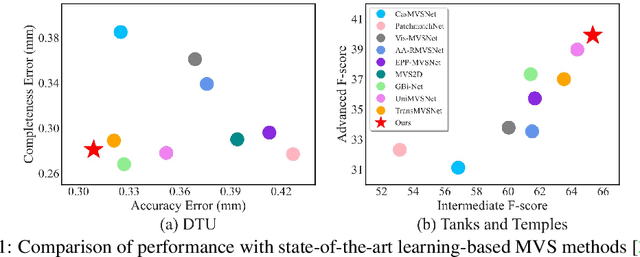
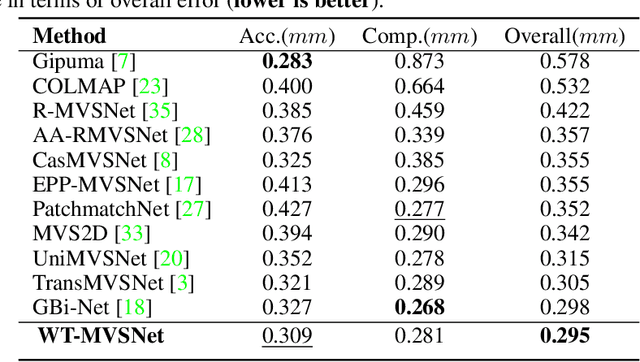
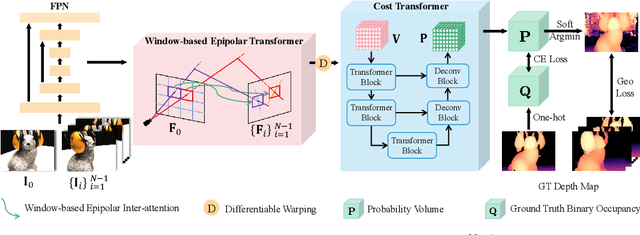
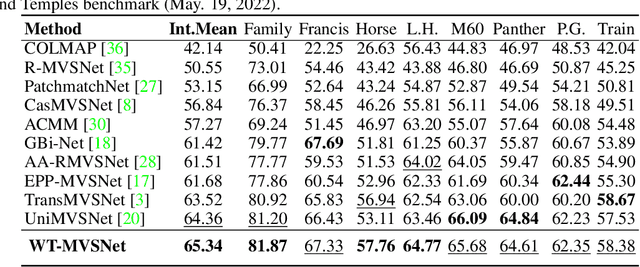
Abstract:Recently, Transformers were shown to enhance the performance of multi-view stereo by enabling long-range feature interaction. In this work, we propose Window-based Transformers (WT) for local feature matching and global feature aggregation in multi-view stereo. We introduce a Window-based Epipolar Transformer (WET) which reduces matching redundancy by using epipolar constraints. Since point-to-line matching is sensitive to erroneous camera pose and calibration, we match windows near the epipolar lines. A second Shifted WT is employed for aggregating global information within cost volume. We present a novel Cost Transformer (CT) to replace 3D convolutions for cost volume regularization. In order to better constrain the estimated depth maps from multiple views, we further design a novel geometric consistency loss (Geo Loss) which punishes unreliable areas where multi-view consistency is not satisfied. Our WT multi-view stereo method (WT-MVSNet) achieves state-of-the-art performance across multiple datasets and ranks $1^{st}$ on Tanks and Temples benchmark.
Adversarial Learning of Hard Positives for Place Recognition
May 08, 2022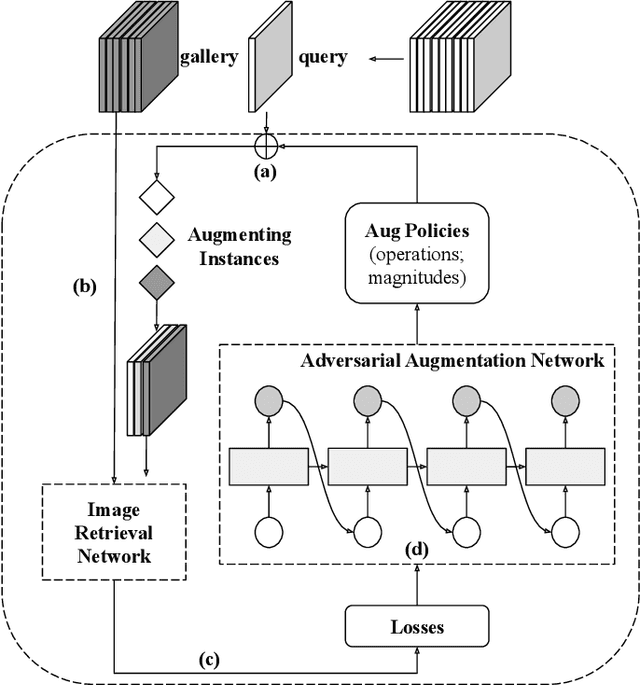
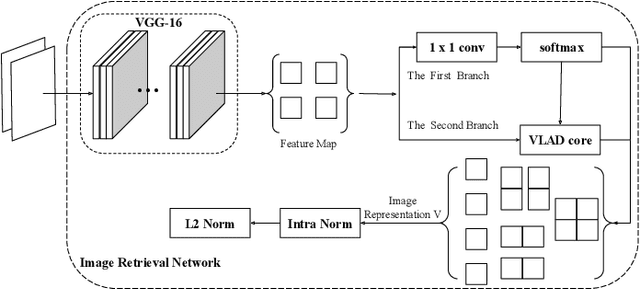
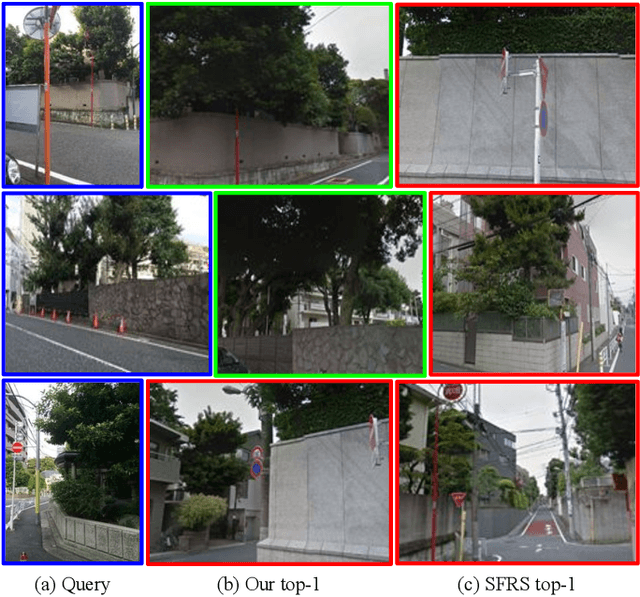

Abstract:Image retrieval methods for place recognition learn global image descriptors that are used for fetching geo-tagged images at inference time. Recent works have suggested employing weak and self-supervision for mining hard positives and hard negatives in order to improve localization accuracy and robustness to visibility changes (e.g. in illumination or view point). However, generating hard positives, which is essential for obtaining robustness, is still limited to hard-coded or global augmentations. In this work we propose an adversarial method to guide the creation of hard positives for training image retrieval networks. Our method learns local and global augmentation policies which will increase the training loss, while the image retrieval network is forced to learn more powerful features for discriminating increasingly difficult examples. This approach allows the image retrieval network to generalize beyond the hard examples presented in the data and learn features that are robust to a wide range of variations. Our method achieves state-of-the-art recalls on the Pitts250 and Tokyo 24/7 benchmarks and outperforms recent image retrieval methods on the rOxford and rParis datasets by a noticeable margin.
ClusterGNN: Cluster-based Coarse-to-Fine Graph Neural Network for Efficient Feature Matching
Apr 25, 2022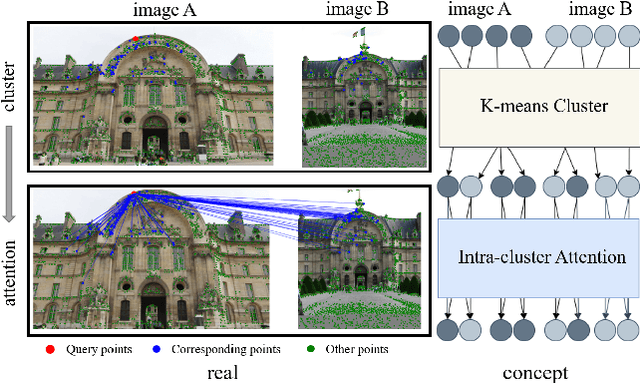
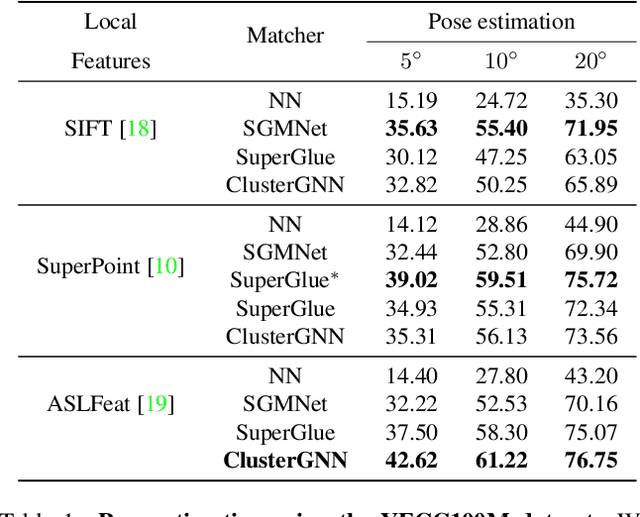
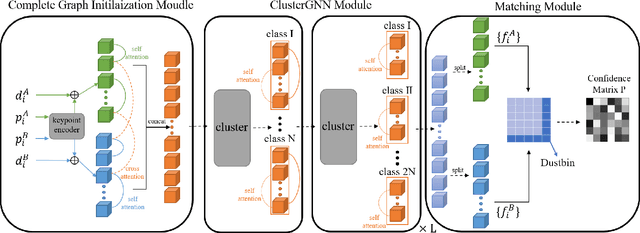
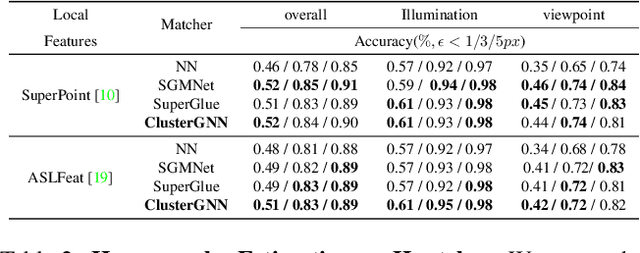
Abstract:Graph Neural Networks (GNNs) with attention have been successfully applied for learning visual feature matching. However, current methods learn with complete graphs, resulting in a quadratic complexity in the number of features. Motivated by a prior observation that self- and cross- attention matrices converge to a sparse representation, we propose ClusterGNN, an attentional GNN architecture which operates on clusters for learning the feature matching task. Using a progressive clustering module we adaptively divide keypoints into different subgraphs to reduce redundant connectivity, and employ a coarse-to-fine paradigm for mitigating miss-classification within images. Our approach yields a 59.7% reduction in runtime and 58.4% reduction in memory consumption for dense detection, compared to current state-of-the-art GNN-based matching, while achieving a competitive performance on various computer vision tasks.
Paying Attention to Activation Maps in Camera Pose Regression
Apr 11, 2021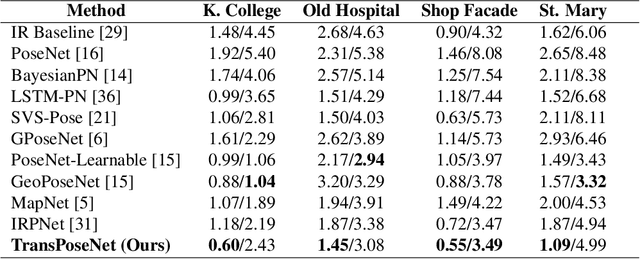

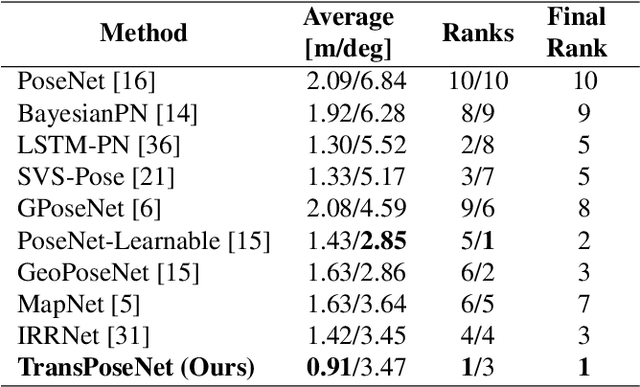

Abstract:Camera pose regression methods apply a single forward pass to the query image to estimate the camera pose. As such, they offer a fast and light-weight alternative to traditional localization schemes based on image retrieval. Pose regression approaches simultaneously learn two regression tasks, aiming to jointly estimate the camera position and orientation using a single embedding vector computed by a convolutional backbone. We propose an attention-based approach for pose regression, where the convolutional activation maps are used as sequential inputs. Transformers are applied to encode the sequential activation maps as latent vectors, used for camera pose regression. This allows us to pay attention to spatially-varying deep features. Using two Transformer heads, we separately focus on the features for camera position and orientation, based on how informative they are per task. Our proposed approach is shown to compare favorably to contemporary pose regressors schemes and achieves state-of-the-art accuracy across multiple outdoor and indoor benchmarks. In particular, to the best of our knowledge, our approach is the only method to attain sub-meter average accuracy across outdoor scenes. We make our code publicly available from here.
Learning Multi-Scene Absolute Pose Regression with Transformers
Mar 21, 2021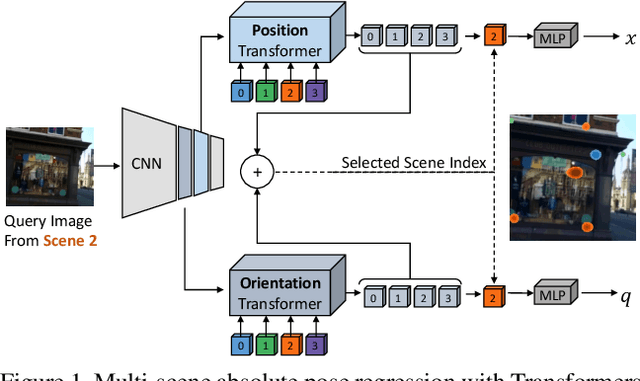
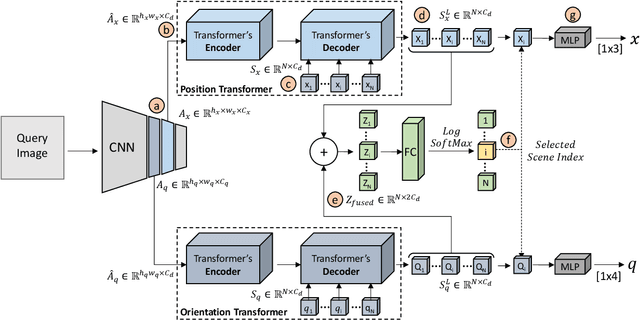
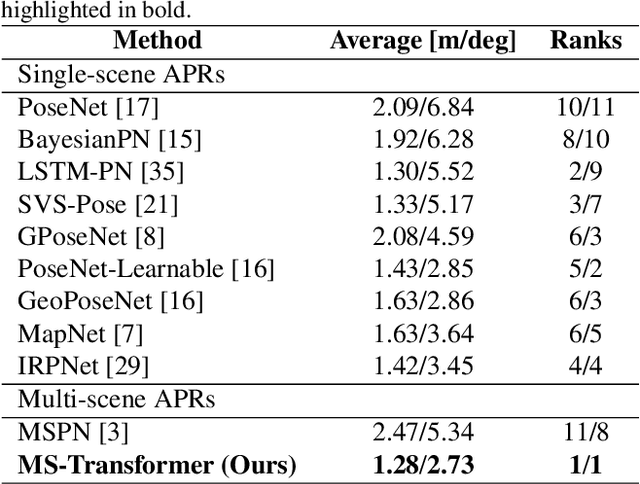
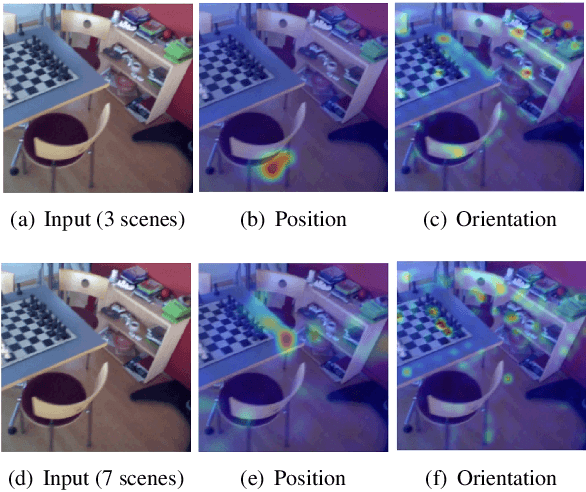
Abstract:Absolute camera pose regressors estimate the position and orientation of a camera from the captured image alone. Typically, a convolutional backbone with a multi-layer perceptron head is trained with images and pose labels to embed a single reference scene at a time. Recently, this scheme was extended for learning multiple scenes by replacing the MLP head with a set of fully connected layers. In this work, we propose to learn multi-scene absolute camera pose regression with Transformers, where encoders are used to aggregate activation maps with self-attention and decoders transform latent features and scenes encoding into candidate pose predictions. This mechanism allows our model to focus on general features that are informative for localization while embedding multiple scenes in parallel. We evaluate our method on commonly benchmarked indoor and outdoor datasets and show that it surpasses both multi-scene and state-of-the-art single-scene absolute pose regressors. We make our code publicly available from here.
Do We Really Need Scene-specific Pose Encoders?
Dec 22, 2020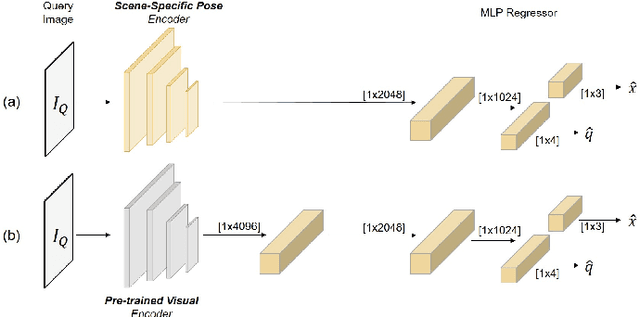

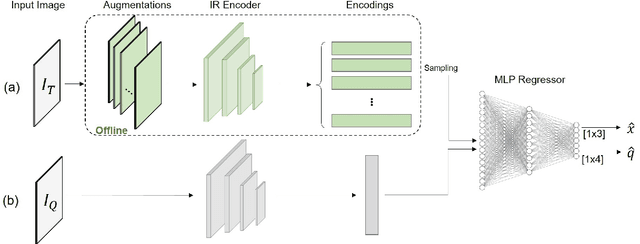

Abstract:Visual pose regression models estimate the camera pose from a query image with a single forward pass. Current models learn pose encoding from an image using deep convolutional networks which are trained per scene. The resulting encoding is typically passed to a multi-layer perceptron in order to regress the pose. In this work, we propose that scene-specific pose encoders are not required for pose regression and that encodings trained for visual similarity can be used instead. In order to test our hypothesis, we take a shallow architecture of several fully connected layers and train it with pre-computed encodings from a generic image retrieval model. We find that these encodings are not only sufficient to regress the camera pose, but that, when provided to a branching fully connected architecture, a trained model can achieve competitive results and even surpass current \textit{state-of-the-art} pose regressors in some cases. Moreover, we show that for outdoor localization, the proposed architecture is the only pose regressor, to date, consistently localizing in under 2 meters and 5 degrees.
Introduction to Camera Pose Estimation with Deep Learning
Jul 16, 2019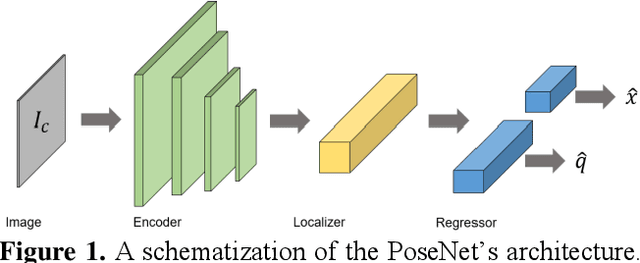
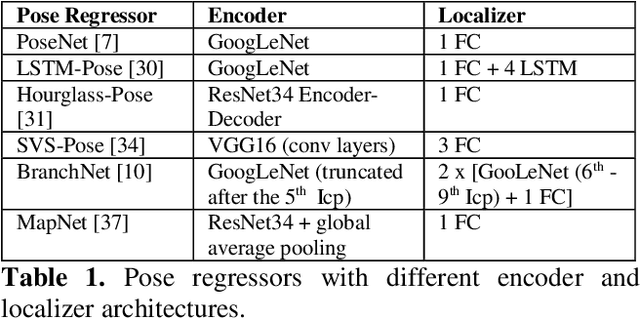
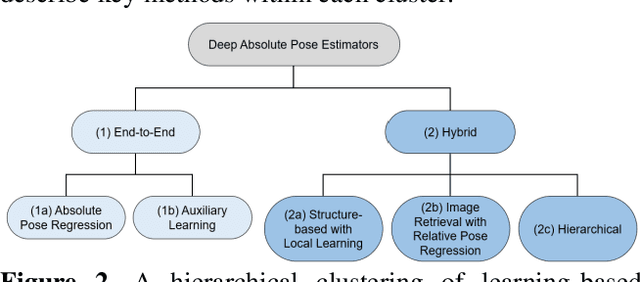
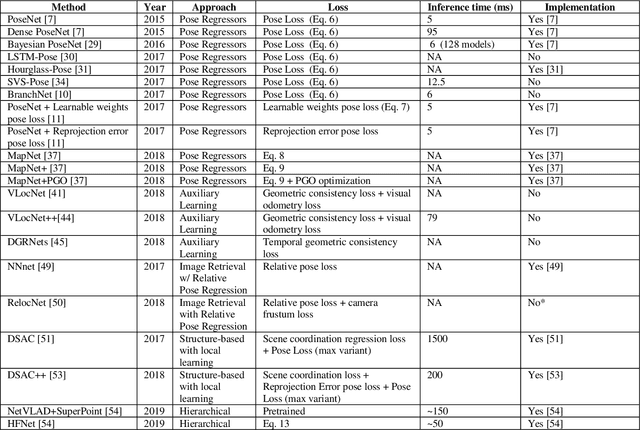
Abstract:Over the last two decades, deep learning has transformed the field of computer vision. Deep convolutional networks were successfully applied to learn different vision tasks such as image classification, image segmentation, object detection and many more. By transferring the knowledge learned by deep models on large generic datasets, researchers were further able to create fine-tuned models for other more specific tasks. Recently this idea was applied for regressing the absolute camera pose from an RGB image. Although the resulting accuracy was sub-optimal, compared to classic feature-based solutions, this effort led to a surge of learning-based pose estimation methods. Here, we review deep learning approaches for camera pose estimation. We describe key methods in the field and identify trends aiming at improving the original deep pose regression solution. We further provide an extensive cross-comparison of existing learning-based pose estimators, together with practical notes on their execution for reproducibility purposes. Finally, we discuss emerging solutions and potential future research directions.
 Add to Chrome
Add to Chrome Add to Firefox
Add to Firefox Add to Edge
Add to Edge